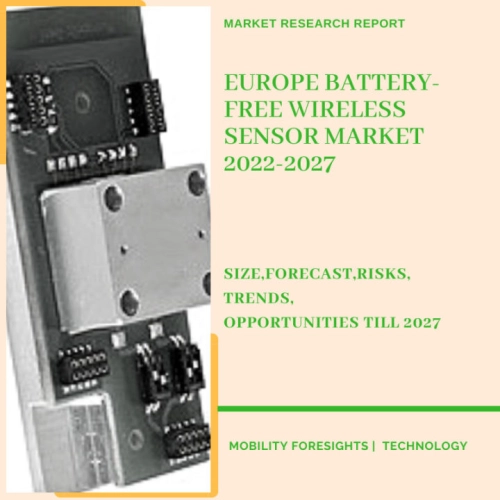
- Get in Touch with Us

Last Updated: Apr 26, 2025 | Study Period: 2022-2027
Battery-free sensors are a cutting-edge technology that has just lately hit the market. Companies are aggressively investing in creating battery-free sensors and increasing their range, including low-frequency sensors because it is a relatively new technology.
Without a battery, a battery-free wireless sensor functions on a radio frequency identification interface. This sensor collects energy from the radio frequency identification reader to power the sensing circuit and then returns the digital data to the reader.

Wireless sensors with no batteries are utilised in the automobile, aerospace and military, consumer electronics, healthcare, and industrial sectors.
Temperature monitoring, tracking, area sensing, pressure sensing, security & surveillance, medical diagnostics, and more applications are included. When opposed to traditional sensors, battery-free wireless sensors may be simply incorporated in automated electronic systems.
The EUROPE BATTERY- FREE WIRELESS SENSOR MARKET accounted for $XX Billion in 2021 and is anticipated to reach $XX Billion by 2026, registering a CAGR of XX% from 2022 to 2027.
WearGRAPH, a two-year project funded by the European Union's Graphene Flagship programme, has created a graphene-based, battery-free, wireless, and flexible power system for wearable electronics.
This novel concept eliminates issues connected with more traditional ways of power supply in wearable devices, such as the inconvenience of charging batteries and safety concerns.
The project, led by Graphene in Germany, has met its goals since its inception: to combine graphene's high degree of connection and flexibility in textiles with energy harvesting and storage to create a self-sufficient wearable gadget.
Scientists have used graphene's unique qualities to build a system in which solar cells and supercapacitors produce electricity, eliminating the need for a lithium-ion battery or frequent pauses for recharging.
The gadget connects with a smartphone by an NFC antenna, which may be combined with a variety of applications.
| Sl no | Topic |
| 1 | Market Segmentation |
| 2 | Scope of the report |
| 3 | Abbreviations |
| 4 | Research Methodology |
| 5 | Executive Summary |
| 6 | Introduction |
| 7 | Insights from Industry stakeholders |
| 8 | Cost breakdown of Product by sub-components and average profit margin |
| 9 | Disruptive innovation in the Industry |
| 10 | Technology trends in the Industry |
| 11 | Consumer trends in the industry |
| 12 | Recent Production Milestones |
| 13 | Component Manufacturing in US, EU and China |
| 14 | COVID-19 impact on overall market |
| 15 | COVID-19 impact on Production of components |
| 16 | COVID-19 impact on Point of sale |
| 17 | Market Segmentation, Dynamics and Forecast by Geography, 2022-2027 |
| 18 | Market Segmentation, Dynamics and Forecast by Product Type, 2022-2027 |
| 19 | Market Segmentation, Dynamics and Forecast by Application, 2022-2027 |
| 20 | Market Segmentation, Dynamics and Forecast by End use, 2022-2027 |
| 21 | Product installation rate by OEM, 2022 |
| 22 | Incline/Decline in Average B-2-B selling price in past 5 years |
| 23 | Competition from substitute products |
| 24 | Gross margin and average profitability of suppliers |
| 25 | New product development in past 12 months |
| 26 | M&A in past 12 months |
| 27 | Growth strategy of leading players |
| 28 | Market share of vendors, 2022 |
| 29 | Company Profiles |
| 30 | Unmet needs and opportunity for new suppliers |
| 31 | Conclusion |
| 32 | Appendix |